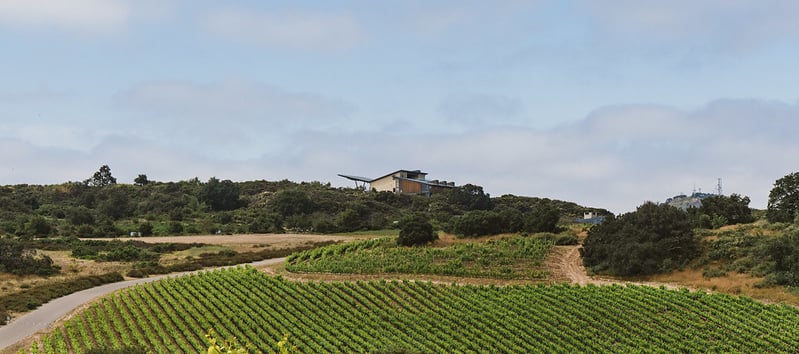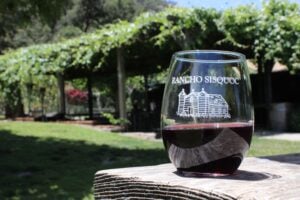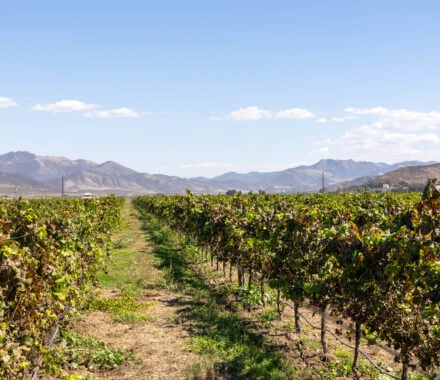Meet our varietals — Chardonnay, Pinot Noir and Syrah
The Santa Maria Valley unfolds along the northern perimeter of Santa Barbara County on California’s Central Coast. The valley’s rare east-west orientation channels cool ocean air directly into the region, bathing the vineyards with cool Pacific fog. Our transverse geography produces a Mediterranean climate and one of California’s longest growing seasons, making for what experts have called “the world’s most dynamic wine-growing region.” The crucial extra time grapes spend on the vine, coupled with our complex soil conditions, makes for more flavorful and balanced grapes.

The Santa Maria Valley AVA has two distinct wine-growing areas, on the Santa Maria Bench and off the Santa Maria Bench. Wines grown on the Santa Maria Bench, which is nestled in the Tepusquet Foothills, have earthier and more rounded textures because of the alluvial soils and foggier weather. Wines grown off the Bench, which is closer to sea level, have fruitier and spicier flavors because they are exposed to more sun. Ultimately, these unique growing regions result in complex Chardonnay, Pinot Noir and Syrah—our valley’s three flagship varietals.
Santa Maria Valley Chardonnay

Chardonnay, a green-skinned grape, is the most popular grape variety in the United States and the most planted white wine-producing grape in the world. Chardonnay is known to be hearty and able to grow in many different climates, but it finds a special home in the Santa Maria Valley’s cool, Mediterranean climate. Chardonnay is most often associated with a rounded, buttery texture and warm flavors. The underlying flavor profile of a wine, including Chardonnays, is largely dependent on how the batch is aged: in oak barrels or in steel barrels. Aging Chardonnay in oak produces strong notes of wood and vanilla while aging it in steel barrels produces crisper, fruitier flavors.
Santa Maria Valley Pinot Noir
 Pinot Noir is a flavorful, light-bodied red grape that produces spicy, acidic and versatile wines. It’s believed that the ancient Romans were some of the first people to grow and produce Pinot Noir. This popular red wine thrives in the same climate as Chardonnay, which is why both varietals grow so well on California’s Central Coast. Pinot Noir is notoriously difficult to grow because the grapes cluster together in tight bunches, making them easy targets for fungi. Pinot Noirs grown in different AVAs throughout the world have different flavor profiles, but Pinot Noir grown on the Central Coast is known for having fruity, spicy and warm vanilla undertones. Like Chardonnay, aging Pinot Noir in oak barrels can make the vanilla undertones more prominent, while aging in steel highlights the fruity notes.
Pinot Noir is a flavorful, light-bodied red grape that produces spicy, acidic and versatile wines. It’s believed that the ancient Romans were some of the first people to grow and produce Pinot Noir. This popular red wine thrives in the same climate as Chardonnay, which is why both varietals grow so well on California’s Central Coast. Pinot Noir is notoriously difficult to grow because the grapes cluster together in tight bunches, making them easy targets for fungi. Pinot Noirs grown in different AVAs throughout the world have different flavor profiles, but Pinot Noir grown on the Central Coast is known for having fruity, spicy and warm vanilla undertones. Like Chardonnay, aging Pinot Noir in oak barrels can make the vanilla undertones more prominent, while aging in steel highlights the fruity notes.
Santa Maria Valley Syrah
 Sometimes known as Shiraz, Syrah is the dark-skinned grape that rounds out Santa Maria Valley’s big three varietals. Throughout the world, Syrah is grown on more acres than Pinot Noir, but on less than Chardonnay. Syrah grapes are responsible for some of the darkest and most full-bodied red wines, and they are much darker than Pinot Noir. Syrah wines are known to have berry undertones, but can surprise sippers with notes of mint, pepper, rosemary, and even meat! Syrah grown and produced in the cool climate of the Santa Maria Valley includes notes of berries and pepper. Syrah is most often aged in oak barrels, but can occasionally be aged in steel.
Sometimes known as Shiraz, Syrah is the dark-skinned grape that rounds out Santa Maria Valley’s big three varietals. Throughout the world, Syrah is grown on more acres than Pinot Noir, but on less than Chardonnay. Syrah grapes are responsible for some of the darkest and most full-bodied red wines, and they are much darker than Pinot Noir. Syrah wines are known to have berry undertones, but can surprise sippers with notes of mint, pepper, rosemary, and even meat! Syrah grown and produced in the cool climate of the Santa Maria Valley includes notes of berries and pepper. Syrah is most often aged in oak barrels, but can occasionally be aged in steel.



